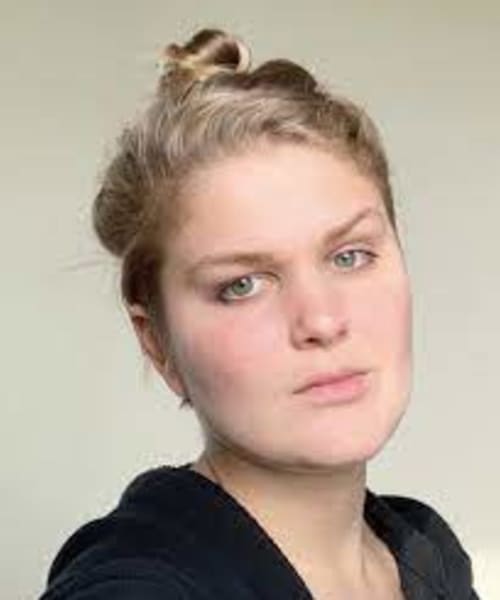
About Hannah Jeremiah
Hannah Jeremiah was born in Van Buren, Arkansas. She currently lives in Fayetteville, Arkansas, where she works across a variety of media. She is now making small drawings and weavings while she writes and researches in preparation for making a series of larger paintings. She received a BFA in Fiber from The Maryland Institute College of Art in 2016. Recent group exhibitions include The 2020 Small Works On Paper Show through the Arkansas Arts Council, Her Voice at The District Galleries in Fort Smith, and The Maximum Exposure Exhibition at Fort Smith Regional Art Museum. She had her first solo exhibition at the Center of Art and Education in Van Buren in August 2020. She was selected for the Jurors Choice Award for the 2020 Adult Art Competition at The Center for Art & Education.
These drawings, made with felt tip pen on paper, reflect a process of layering images from my surroundings. I intentionally work without a plan because it allows memories and dynamics below my conscious awareness to become articulated. Through describing each drawing in words, I gain insight into my psychology, memory, and perception of my body. The process of writing about each work integrates the memories in my mind and makes me feel more whole. Many of these works reflect dissociated memories' emotional reality flooding in the form of images with no words and body sensations that can't easily be named. The people in these drawings often have their mouths open and look like they are in a state of shock. I drew people this way because that was how I felt in those years. Bodies also became articulated in the way I perceived my own - disconnected and in parts, limbs floating off into the ether, objects disrupting the figure's presence as if assaulting the body. The vessels feel as though they represent a human body - disrupted and drawn in disparate parts, never drawn completely. As I create the work, my hands translate my body memories onto the page. Drawing is a habit, almost a compulsion, that comes from my childhood. It allows me to process aspects of my reality with no words or can't easily be put into words. The continued practice of drawing allows me to access childlike states of being and translate my past selves' emotional realities onto the page. I am currently working on a series of drawings with bubble letter phrases that describe childhood memories. I think this process of putting words into the images gives me more agency in naming fundamental aspects and describing the memories that made me disassociate and disconnect in the first place. Naming the narrative of my life in a concrete form feels essential to healing from trauma, relating my experiences to collective dynamics in society, and ultimately recording our time's history.
About the art
Hannah Jeremiah was born in Van Buren, Arkansas. She currently lives in Fayetteville, Arkansas, where she works across a variety of media. She is now making small drawings and weavings while she writes and researches in preparation for making a series of larger paintings. She received a BFA in Fiber from The Maryland Institute College of Art in 2016. Recent group exhibitions include The 2020 Small Works On Paper Show through the Arkansas Arts Council, Her Voice at The District Galleries in Fort Smith, and The Maximum Exposure Exhibition at Fort Smith Regional Art Museum. She had her first solo exhibition at the Center of Art and Education in Van Buren in August 2020. She was selected for the Jurors Choice Award for the 2020 Adult Art Competition at The Center for Art & Education.
These drawings, made with felt tip pen on paper, reflect a process of layering images from my surroundings. I intentionally work without a plan because it allows memories and dynamics below my conscious awareness to become articulated. Through describing each drawing in words, I gain insight into my psychology, memory, and perception of my body. The process of writing about each work integrates the memories in my mind and makes me feel more whole. Many of these works reflect dissociated memories' emotional reality flooding in the form of images with no words and body sensations that can't easily be named. The people in these drawings often have their mouths open and look like they are in a state of shock. I drew people this way because that was how I felt in those years. Bodies also became articulated in the way I perceived my own - disconnected and in parts, limbs floating off into the ether, objects disrupting the figure's presence as if assaulting the body. The vessels feel as though they represent a human body - disrupted and drawn in disparate parts, never drawn completely. As I create the work, my hands translate my body memories onto the page. Drawing is a habit, almost a compulsion, that comes from my childhood. It allows me to process aspects of my reality with no words or can't easily be put into words. The continued practice of drawing allows me to access childlike states of being and translate my past selves' emotional realities onto the page. I am currently working on a series of drawings with bubble letter phrases that describe childhood memories. I think this process of putting words into the images gives me more agency in naming fundamental aspects and describing the memories that made me disassociate and disconnect in the first place. Naming the narrative of my life in a concrete form feels essential to healing from trauma, relating my experiences to collective dynamics in society, and ultimately recording our time's history.
